*NURSING > TEST BANK > Lowdermilk-Maternity and Women's Health Care - TB.pdf : NURS MISC : North Central Texas College | Co (All)
Lowdermilk-Maternity and Women's Health Care - TB.pdf : NURS MISC : North Central Texas College | Course Hero
Document Content and Description Below
1. In evaluating the level of a pregnant woman’s risk of having a low-birth-weight (LBW) infant, which factor is the most important for the nurse to consider? a. African-American race b. Cigarett... e smoking c. Poor nutritional status d. Limited maternal education ANS: A For African-American births, the incidence of LBW infants is twice that of Caucasian births. Race is a nonmodifiable risk factor. Cigarette smoking is an important factor in potential infant mortality rates, but it is not the most important. Additionally, smoking is a modifiable risk factor. Poor nutrition is an important factor in potential infant mortality rates, but it is not the most important. Additionally, nutritional status is a modifiable risk factor. Maternal education is an important factor in potential infant mortality rates, but it is not the most important. Additionally, maternal education is a modifiable risk factor. DIF: Cognitive Level: Understand REF: p. 6 TOP: Nursing Process: Assessment MSC: Client Needs: Health Promotion and Maintenance, Antepartum Care 2. What is the primary role of practicing nurses in the research process? a. Designing research studies b. Collecting data for other researchers c. Identifying researchable problems d. Seeking funding to support research studies ANS: C When problems are identified, research can be properly conducted. Research of health care issues leads to evidence-based practice guidelines. Designing research studies is only one factor of the research process. Data collection is another factor of research. Financial support is necessary to conduct research, but it is not the primary role of the nurse in the research process. DIF: Cognitive Level: Understand REF: p. 14 TOP: Nursing Process: N/A MSC: Client Needs: Safe and Effective Care Environment 3. A 23-year-old African-American woman is pregnant with her first child. Based on the statistics for infant mortality, which plan is most important for the nurse to implement? a. Perform a nutrition assessment. b. Refer the woman to a social worker. c. Advise the woman to see an obstetrician, not a midwife. d. Explain to the woman the importance of keeping her prenatal care appointments. ANS: D Consistent prenatal care is the best method of preventing or controlling risk factors associated with infant mortality. Nutritional status is an important modifiable risk factor, but it is not the most important action a nurse should take in this situation. The client may need assistance from a social worker at some time during her pregnancy, but a referral to a social worker is not the most important aspect the nurse should address at this time. If the woman has identifiable high-risk problems, then her health care may need to be provided by a physician. However, it cannot be assumed that all African-American women have high-risk issues. In addition, advising the woman to see an obstetrician is not the most important aspect on which the nurse should focus at this time, and it is not appropriate for a nurse to advise or manage the type of care a client is to receive. DIF: Cognitive Level: Understand REF: p. 6 TOP: Nursing Process: Planning MSC: Client Needs: Health Promotion and Maintenance 4. During a prenatal intake interview, the nurse is in the process of obtaining an initial assessment of a 21-year-old Hispanic client with limited English proficiency. Which action is the most important for the nurse to perform? a. Use maternity jargon to enable the client to become familiar with these terms. b. Speak quickly and efficiently to expedite the visit. c. Provide the client with handouts. d. Assess whether the client understands the discussion. ANS: D Nurses contribute to health literacy by using simple, common words, avoiding jargon, and evaluating whether the client understands the discussion. Speaking slowly and clearly and focusing on what is important will increase understanding. Most client education materials are written at a level too high for the average adult and may not be useful for a client with limited English proficiency. DIF: Cognitive Level: Apply REF: p. 5 TOP: Nursing Process: Evaluation MSC: Client Needs: Health Promotion and Maintenance 5. The nurses working at a newly established birthing center have begun to compare their performance in providing maternal-newborn care against clinical standards. This comparison process is most commonly known as what? a. Best practices network b. Clinical benchmarking c. Outcomes-oriented practice d. Evidence-based practice ANS: C Outcomes-oriented practice measures the effectiveness of the interventions and quality of care against benchmarks or standards. The term best practice refers to a program or service that has been recognized for its excellence. Clinical benchmarking is a process used to compare one’s own performance against the performance of the best in an area of service. The term evidence-based practice refers to the provision of care based on evidence gained through research and clinical trials. DIF: Cognitive Level: Understand REF: p. 11 TOP: Nursing Process: Evaluation MSC: Client Needs: Safe and Effective Care Environment 6. Which statement best exemplifies contemporary maternity nursing? a. Use of midwives for all vaginal deliveries b. Family-centered care c. Free-standing birth clinics d. Physician-driven care ANS: B Contemporary maternity nursing focuses on the family’s needs and desires. Fathers, partners, grandparents, and siblings may be present for the birth and participate in activities such as cutting the baby’s umbilical cord. Both midwives and physicians perform vaginal deliveries. Free-standing clinics are an example of alternative birth options. Contemporary maternity nursing is driven by the relationship between nurses and their clients. DIF: Cognitive Level: Understand REF: pp. 8-9 TOP: Nursing Process: Planning MSC: Client Needs: Health Promotion and Maintenance 7. A 38-year-old Hispanic woman vaginally delivered a 9-pound, 6-ounce baby girl after being in labor for 43 hours. The baby died 3 days later from sepsis. On what grounds could the woman have a legitimate legal case for negligence? a. Inexperienced maternity nurse was assigned to care for the client. b. Client was past her due date by 3 days. c. Standard of care was not met. d. Client refused electronic fetal monitoring. ANS: C Not meeting the standard of care is a legitimate factor for a case of negligence. An inexperienced maternity nurse would need to display competency before being assigned to care for clients on his or her own. This client may have been past her due date; however, a term pregnancy often goes beyond 40 weeks of gestation. Although fetal monitoring is the standard of care, the client has the right to refuse treatment. This refusal is not a case for negligence, but informed consent should be properly obtained, and the client should have signed an against medical advice form when refusing any treatment that is within the standard of care. DIF: Cognitive Level: Analyze REF: p. 13 TOP: Nursing Process: Implementation MSC: Client Needs: Safe and Effective Care Environment 8. When the nurse is unsure how to perform a client care procedure that is high risk and low volume, his or her best action in this situation would be what? a. Ask another nurse. b. Discuss the procedure with the client’s physician. c. Look up the procedure in a nursing textbook. d. Consult the agency procedure manual, and follow the guidelines for the procedure. ANS: D Following the agency’s policies and procedures manual is always best when seeking information on correct client procedures. These policies should reflect the current standards of care and the individual state’s guidelines. Each nurse is responsible for his or her own practice. Relying on another nurse may not always be a safe practice. Each nurse is obligated to follow the standards of care for safe client care delivery. Physicians are responsible for their own client care activity. Nurses may follow safe orders from physicians, but they are also responsible for the activities that they, as nurses, are to carry out. Information provided in a nursing textbook is basic information for general knowledge. Furthermore, the information in a textbook may not reflect the current standard of care or the individual state or hospital policies. DIF: Cognitive Level: Understand REF: p. 13 TOP: Nursing Process: Implementation MSC: Client Needs: Physiologic Integrity 9. The National Quality Forum has issued a list of “never events” specifically pertaining to maternal and child health. These include all of the following except: a. infant discharged to the wrong person. b. kernicterus associated with the failure to identify and treat hyperbilirubinemia. c. artificial insemination with the wrong donor sperm or egg. d. foreign object retained after surgery. ANS: D Although a foreign object retained after surgery is a never event, it does not specifically pertain to obstetric clients. A client undergoing any type of surgery may be at risk for this event. An infant discharged to the wrong person specifically pertains to postpartum care. Death or serious disability as a result of kernicterus pertains to newborn assessment and care. Artificial insemination affects families seeking care for infertility. DIF: Cognitive Level: Remember REF: p. 4 TOP: Nursing Process: Implementation MSC: Client Needs: Safe and Effective Care Environment 10. A nurse caring for a pregnant client should be aware that the U.S. birth rate shows what trend? a. Births to unmarried women are more likely to have less favorable outcomes. b. Birth rates for women 40 to 44 years of age are declining. c. Cigarette smoking among pregnant women continues to increase. d. Rates of pregnancy and abortion among teenagers are lower in the United States than in any other industrialized country. ANS: A LBW infants and preterm births are more likely because of the large number of teenagers in the unmarried group. Birth rates for women in their early 40s continue to increase. Fewer pregnant women smoke. Teen pregnancy and abortion rates are higher in the United States than in any other industrial country. DIF: Cognitive Level: Understand REF: p. 6 TOP: Nursing Process: Assessment MSC: Client Needs: Psychosocial Inte [Show More]
Last updated: 1 year ago
Preview 1 out of 412 pages

Reviews( 0 )
Document information
Connected school, study & course
About the document
Uploaded On
Jan 31, 2023
Number of pages
412
Written in
Additional information
This document has been written for:
Uploaded
Jan 31, 2023
Downloads
0
Views
68


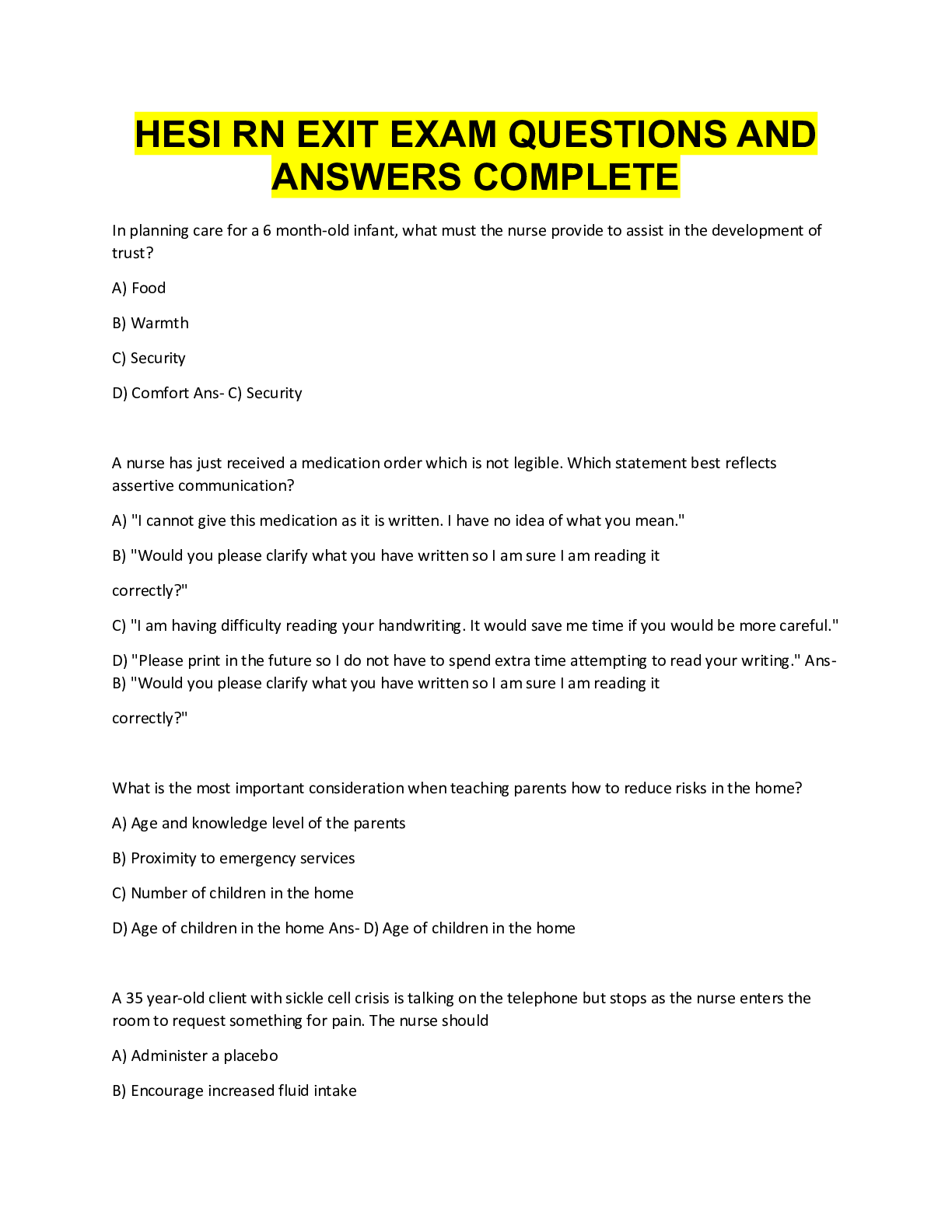
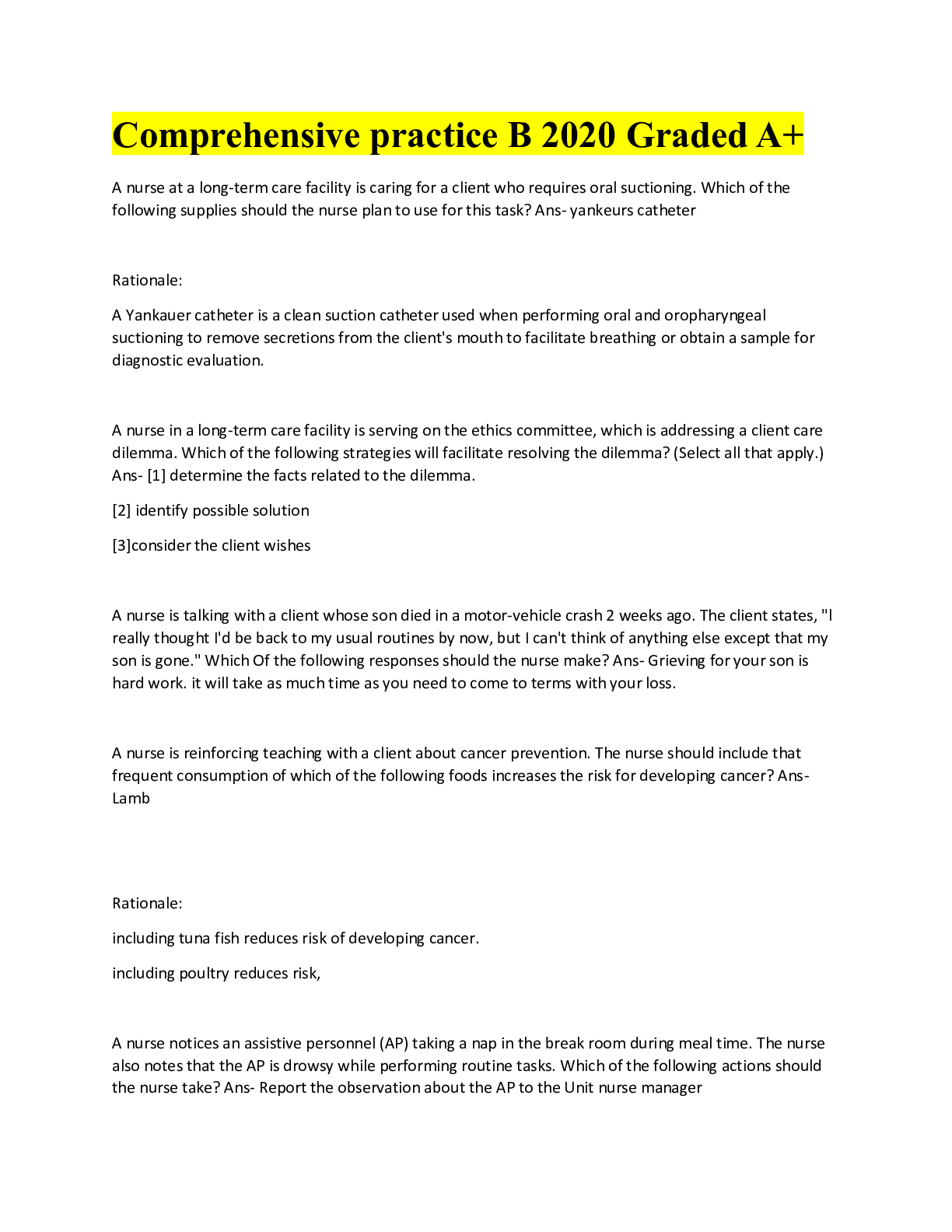
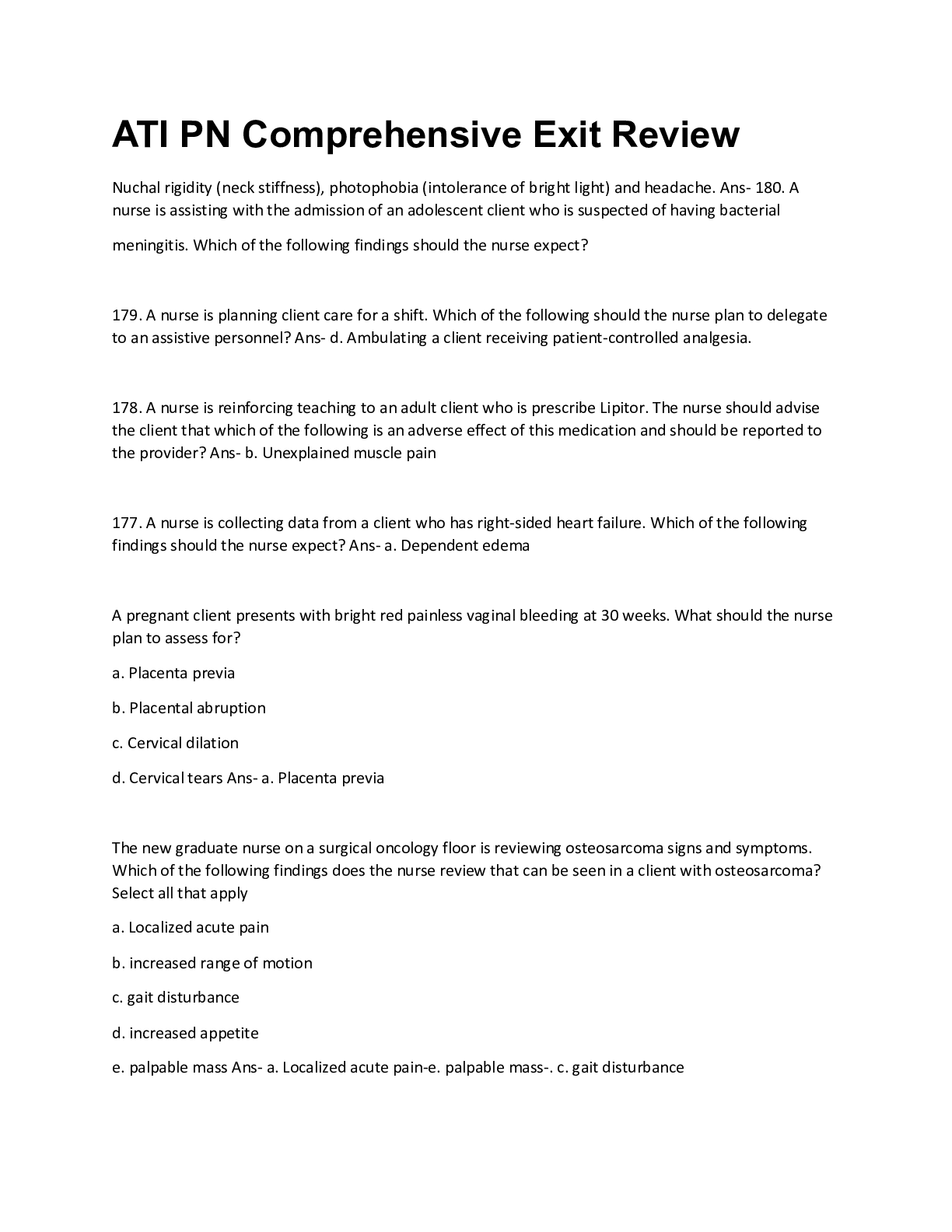

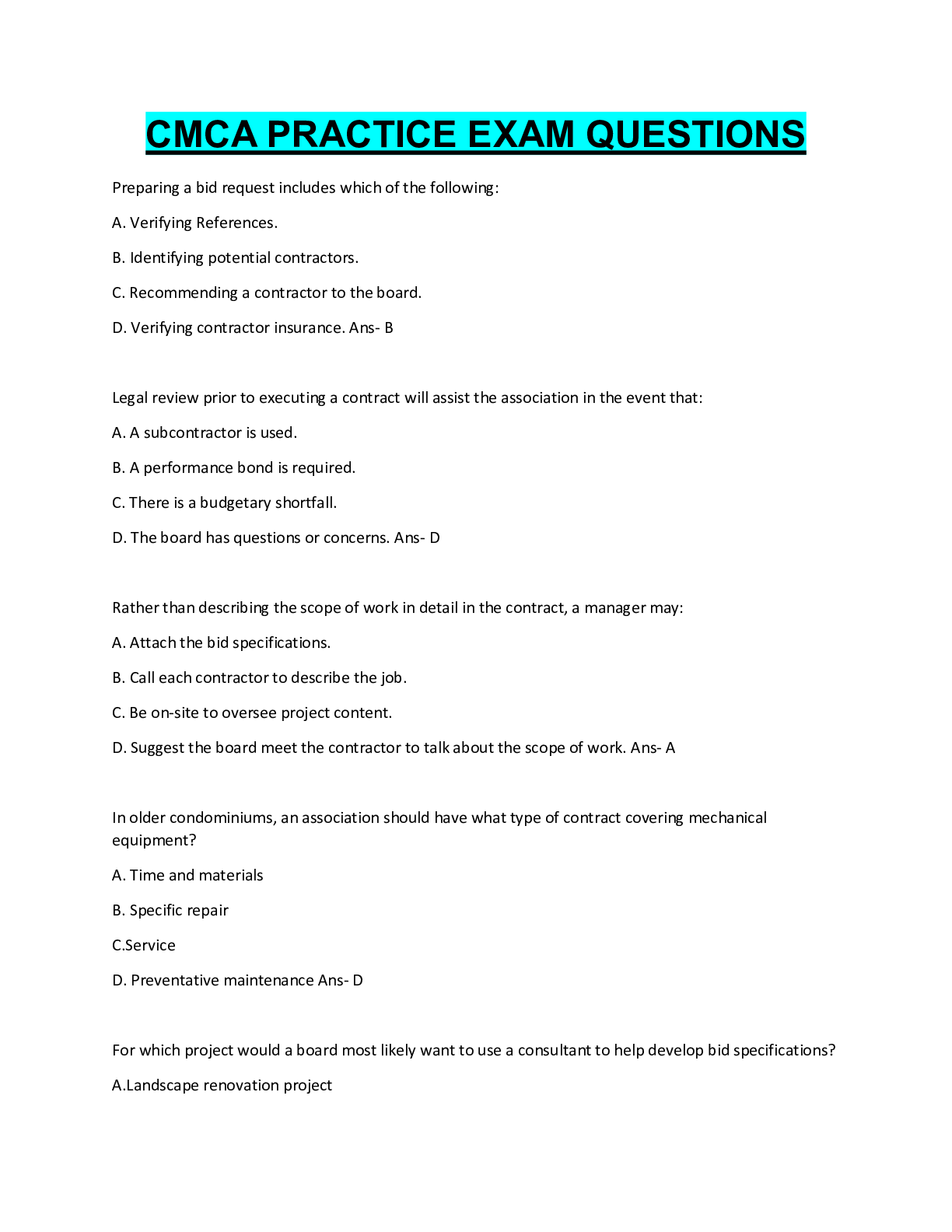

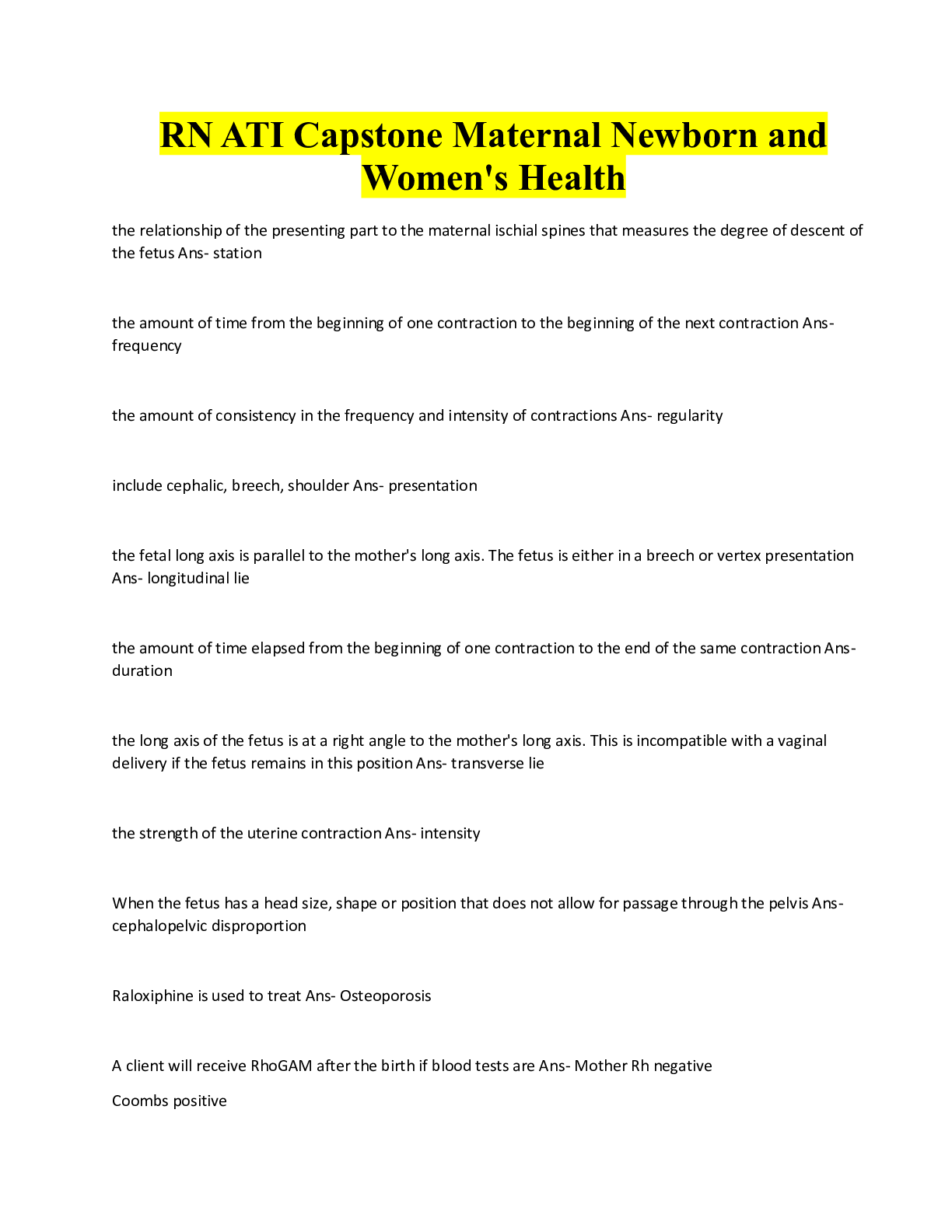
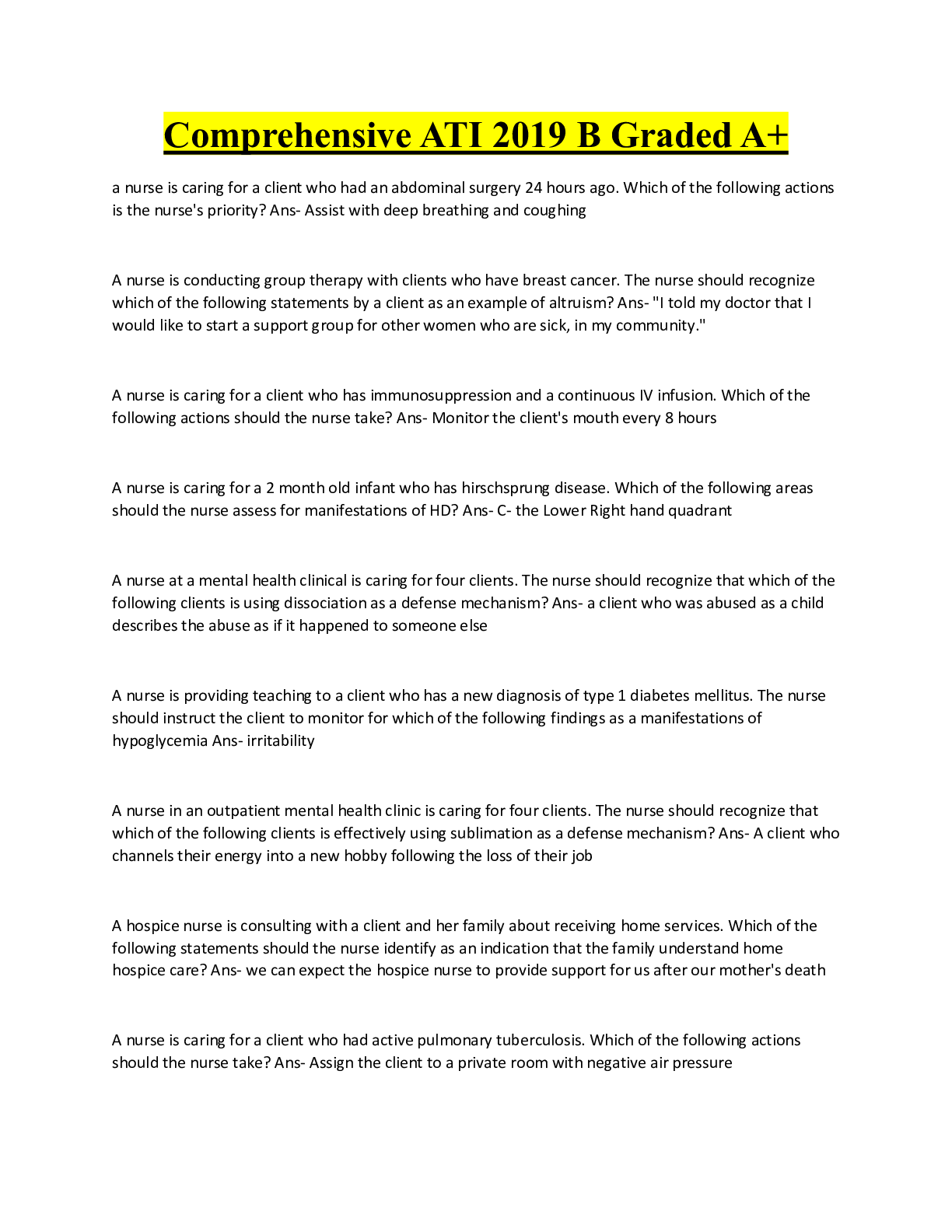

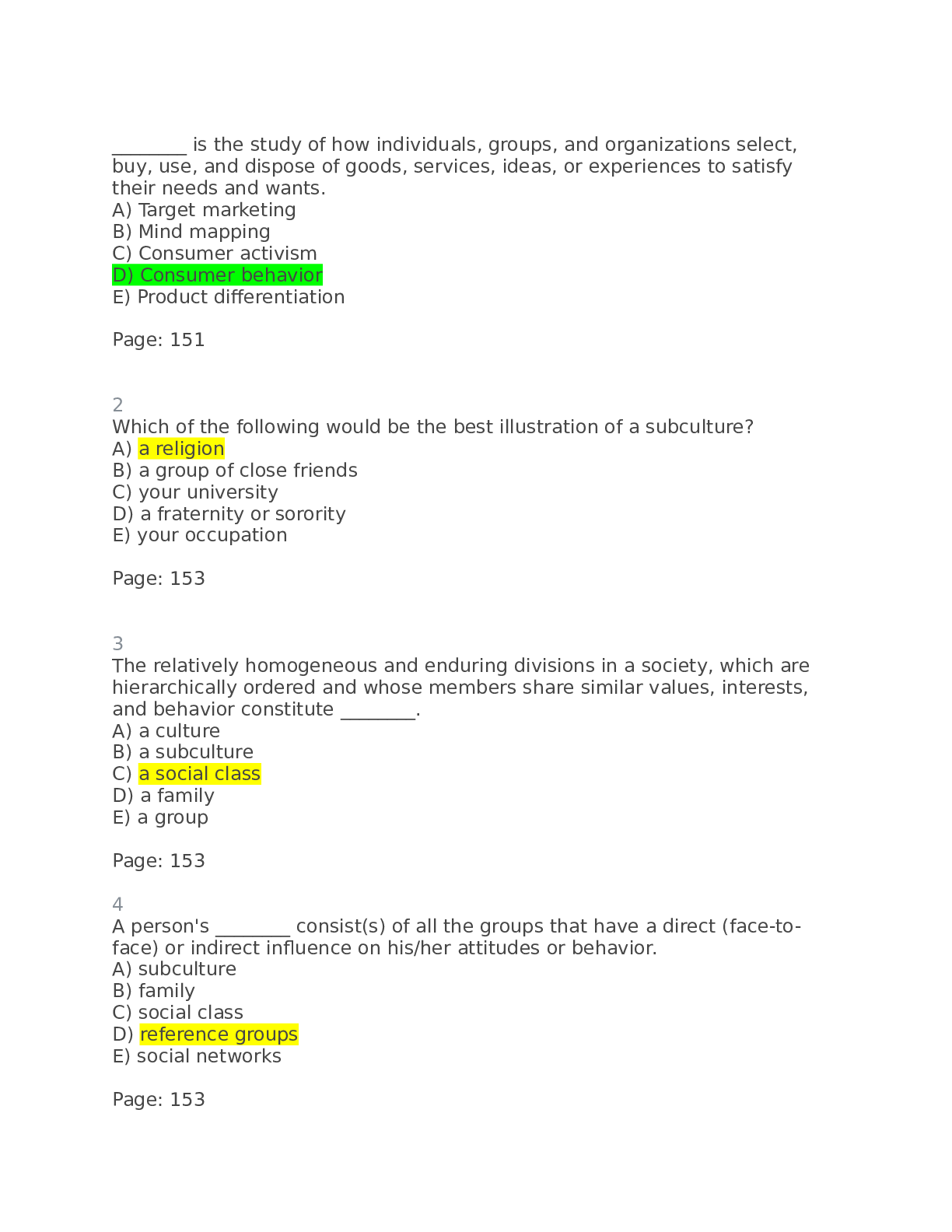
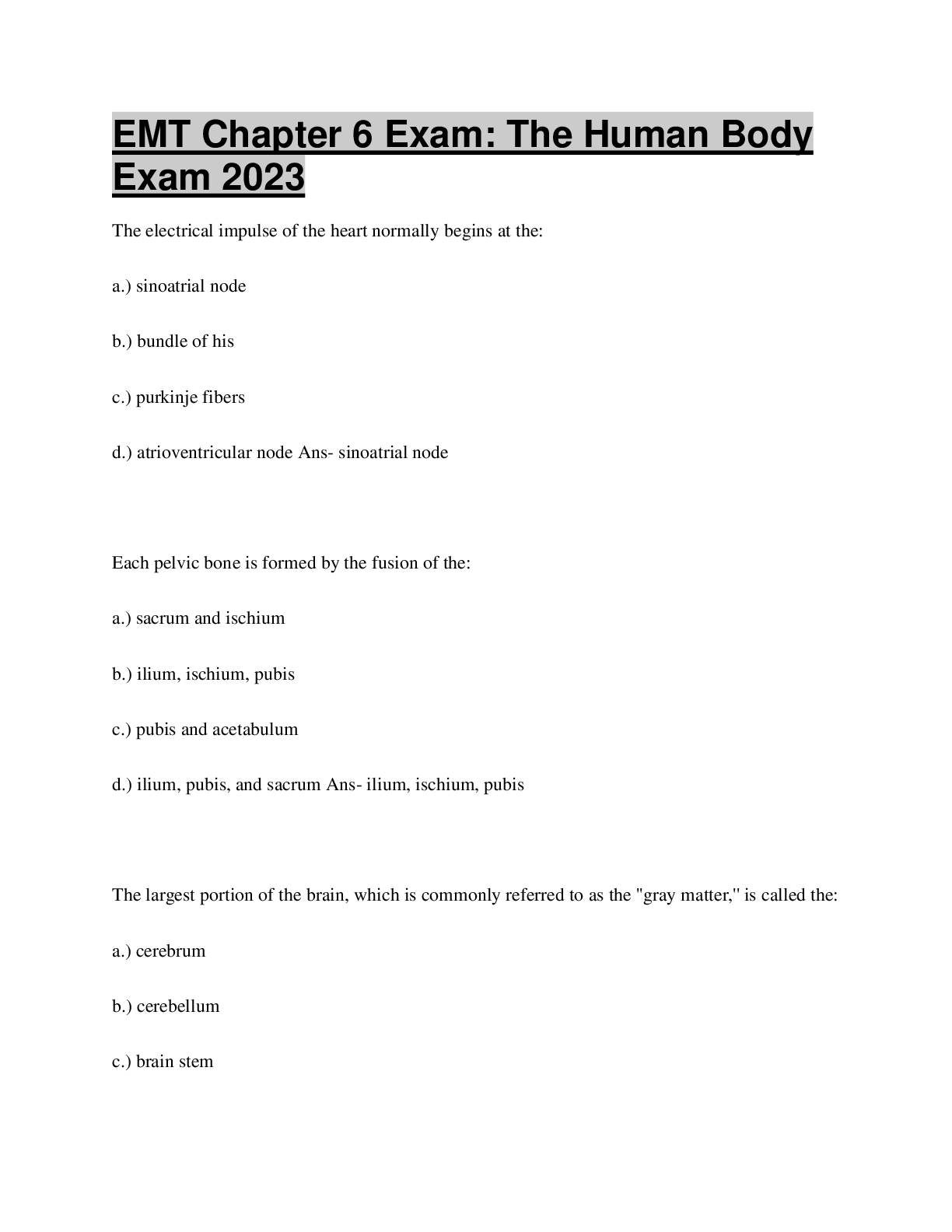

.png)


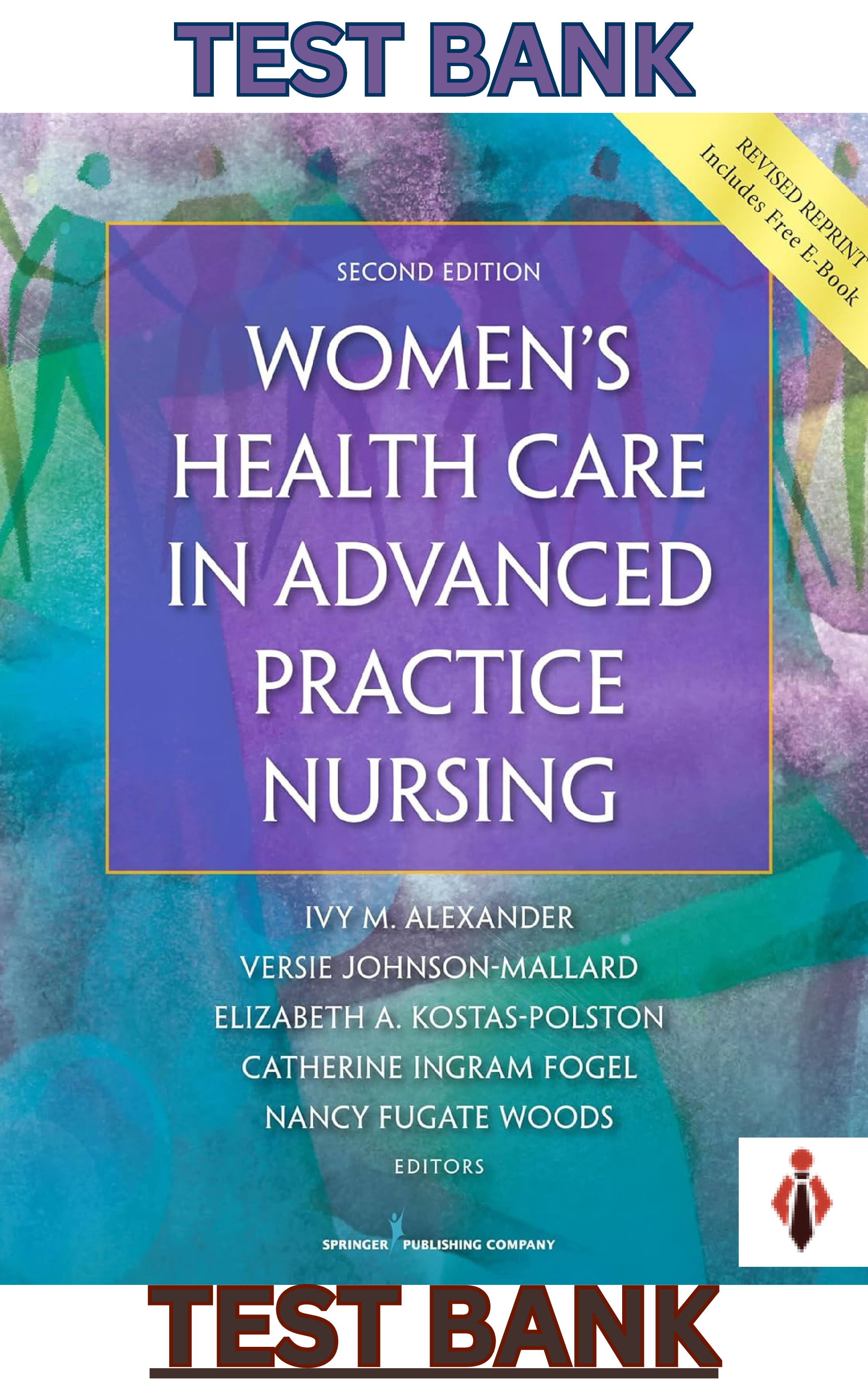

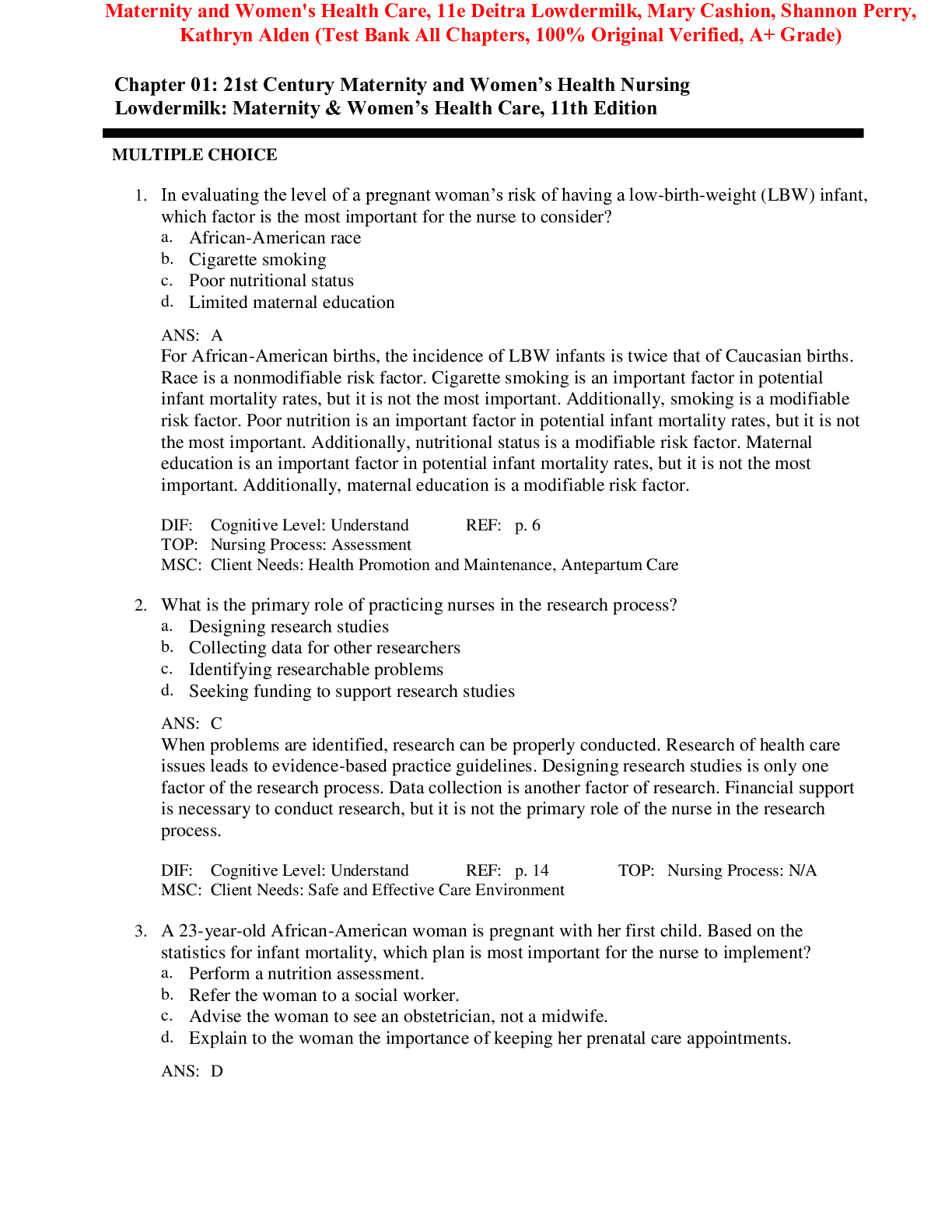


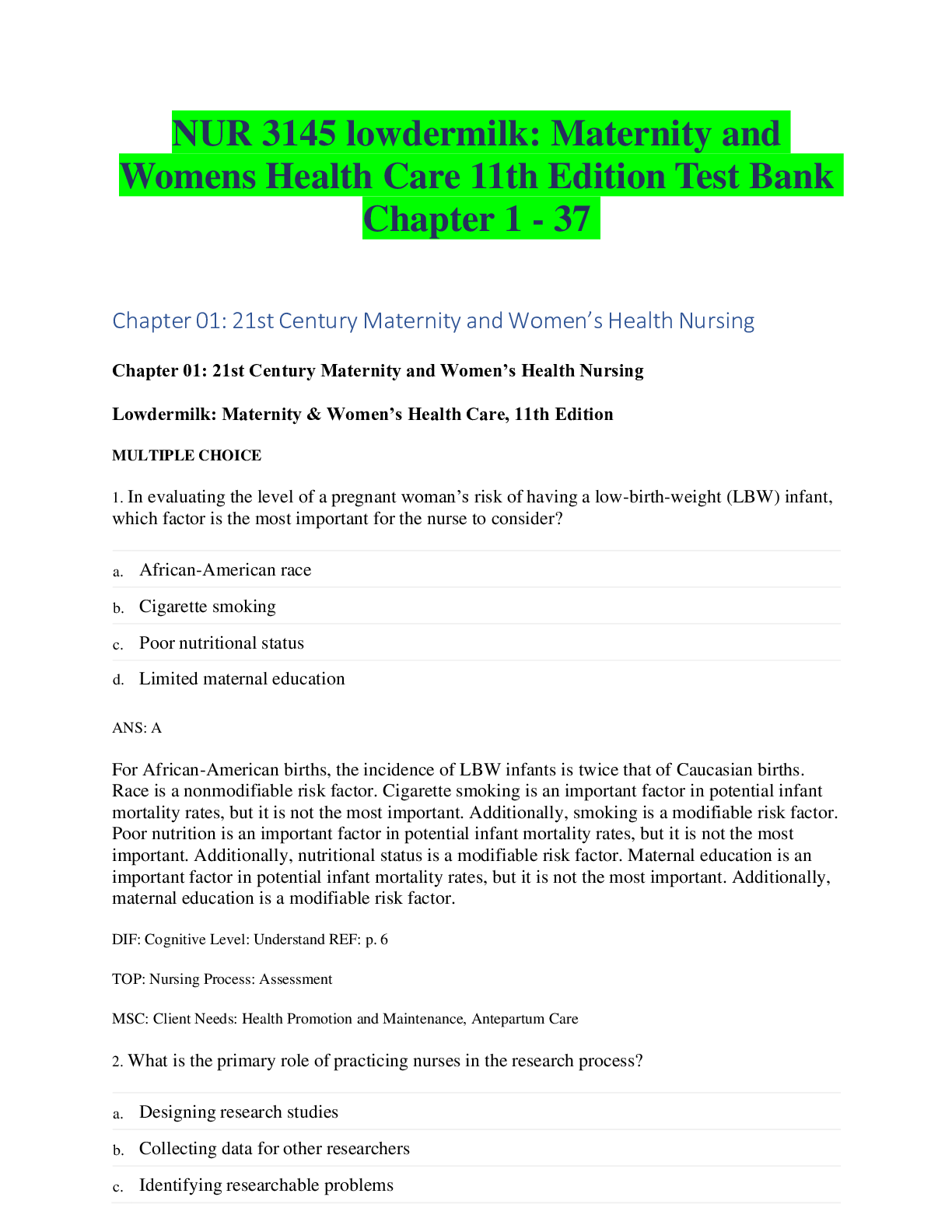


.png)
.png)


